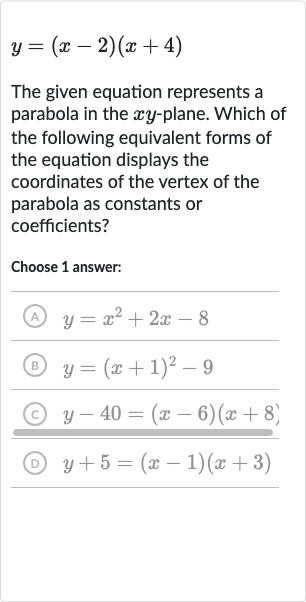Full solution
Q. The given equation represents a parabola in the -plane. Which of the following equivalent forms of the equation displays the coordinates of the vertex of the parabola as constants or coefficients?Choose answer:(A) (B) (C) (D)
- Expand and Match: To find the vertex form of the equation, we need to complete the square. The vertex form of a parabola's equation is , where is the vertex of the parabola.
- Convert to Vertex Form: First, let's expand the given equation to see if it matches any of the answer choices.This matches answer choice (A), but this form does not show the vertex.
- Check Answer Choices: Now, let's try to convert the expanded form into the vertex form by completing the square.We have .To complete the square, we take the coefficient of , which is , divide it by , and square it. .We add and subtract this number inside the equation to complete the square.This matches answer choice (B) and shows the vertex as .
- Final Answer: None of the other answer choices are in vertex form, so we do not need to check them further. Answer choice (B) is the correct answer because it is in vertex form and displays the coordinates of the vertex of the parabola as constants or coefficients.
More problems from Domain and range of quadratic functions: equations
QuestionGet tutor help
QuestionGet tutor help
QuestionGet tutor help
QuestionGet tutor help
QuestionGet tutor help
QuestionGet tutor help
QuestionGet tutor help
QuestionGet tutor help

